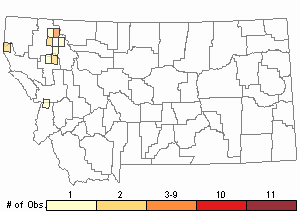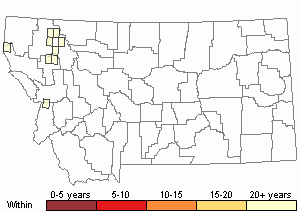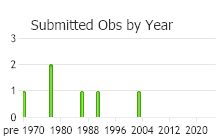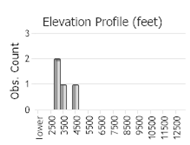View in other NatureServe Network Field Guides
NatureServe
Montana
Utah
Wyoming
Idaho
Wisconsin
British Columbia
South Carolina
Yukon
California
New York
A Heterocladium Moss - Heterocladium procurrens
General Description
Plants: Pleurocarpous, growing in wide-spreading horizontal mats (Lawton 1971), frequently green with yellow or reddish tones, shiny (FNA 2014). Stems somewhat pinnate, frequently arching and with rhizoids at the tips; paraphyllia unbranched or branched, frequently few and not particularly noticeable (Lawton 1971); superficial cells smooth (FNA 2014).
Stem Leaves: Spreading to 90 degrees when dry or damp, 1-2 mm in length, egg-shaped (FNA 2014) to deltoid from the heart-shaped base, the base cupped and extending down the stem (Lawton 1971), the tip acuminate (FNA 2014), and long and slender (Lawton 1971); leaf edges flat, finely saw-toothed; costa double, about half the leaf length (FNA 2014).
Branch Leaves: Those of larger branches similar to stem leaves; those of smaller branches 0.4-0.8 mm in length, the leaf tip not long and slender (Lawton 1971), egg-shaped (FNA 2014) or barely heart-shaped (Lawton 1971).
Leaf Cells: Laminal cells square to diamond-shaped, smooth (FNA 2014); median laminal cells slightly porose and with walls a little thickened, the cells distally and at the margins shorter (Lawton 1971); basal cells near the costa and those extending to the leaf attachment elongate (FNA 2014); alar cells square to short-oblong (Lawton 1971).
Diagnostic Characteristics
Plants of Heterocladium dimorphum, with their leaves spreading less widely than those of H. procurrens, appear smaller. Their leaves are also dull rather than glossy, and their laminal cells are papillose rather than smooth (FNA 2014).
Range Comments
North American Range
AK, BC to OR, also ID and MT (FNA 2014). Known in Montana from Flathead, Glacier, Lake, Lincoln, and Sanders Counties (Elliott and Pipp 2016).
Observations in Montana Natural Heritage Program Database
Number of Observations: 20
(Click on the following maps and charts to see full sized version)
Map Help and Descriptions
Relative Density

Recency



 (Observations spanning multiple months or years are excluded from time charts)
(Observations spanning multiple months or years are excluded from time charts)
Habitat
Stone, soil, organic soil, decaying wood, bark of tree bottoms (FNA 2014). From the lowlands to medium elevations (FNA 2014), reaching about 5910 feet (Lawton 1971).
Reproductive Characteristics
Dioicous. Seta 15-20 mm tall (Lawton 1971). Capsule level, bowed, brown (FNA 2014), 1.8-2.3 mm in length, a little shrunken below the opening when dry (Lawton 1971); peristome perfect, with somewhat long, knobby cilia (FNA 2014).
Stewardship Responsibility
References
- Literature Cited AboveLegend:
 View Online Publication
View Online Publication Elliott, J.C. and A.K. Pipp. 2018. A Checklist of Montana Mosses (1880-2018). Updated 3 January, 2020. Montana Natural Heritage Program, Helena, Montana. 73 pp.
Elliott, J.C. and A.K. Pipp. 2018. A Checklist of Montana Mosses (1880-2018). Updated 3 January, 2020. Montana Natural Heritage Program, Helena, Montana. 73 pp. Flora of North America Editorial Committee, eds. 2014. Flora of North America North of Mexico. Volume 28. Bryophytes: Mosses, Part 2. Oxford University Press, Inc., NY. xxi + 702 pp.
Flora of North America Editorial Committee, eds. 2014. Flora of North America North of Mexico. Volume 28. Bryophytes: Mosses, Part 2. Oxford University Press, Inc., NY. xxi + 702 pp. Lawton, E. 1971. Moss Flora of the Pacific Northwest. Hattori Botanical Laboratory. Japan: Yamabuki-cho, Shinjuku-ku, Tokyo. 362 pages plus appendices.
Lawton, E. 1971. Moss Flora of the Pacific Northwest. Hattori Botanical Laboratory. Japan: Yamabuki-cho, Shinjuku-ku, Tokyo. 362 pages plus appendices.
- Additional ReferencesLegend:
 View Online Publication
View Online Publication
Do you know of a citation we're missing? Elliot, J. C. 1993. Second checklist of Montana mosses. Unpublished report. U.S. Forest Service, Region 1. Missoula, MT. 45 pp.
Elliot, J. C. 1993. Second checklist of Montana mosses. Unpublished report. U.S. Forest Service, Region 1. Missoula, MT. 45 pp. Lawton, E. 1971. Keys for the Identification of the Mosses on the Pacific Northwest. Reprinted from 'Moss Flora of the Pacific Northwest'. Published as Supplement No. 2 of the Journal of the Hattori Botanical Laboratory. Nichinan, Miyazaki, Japan. 66 pp.
Lawton, E. 1971. Keys for the Identification of the Mosses on the Pacific Northwest. Reprinted from 'Moss Flora of the Pacific Northwest'. Published as Supplement No. 2 of the Journal of the Hattori Botanical Laboratory. Nichinan, Miyazaki, Japan. 66 pp.
- Web Search Engines for Articles on "A Heterocladium Moss"





